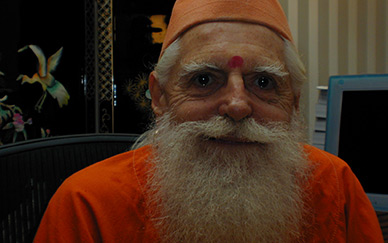Monthly Satsang at Sankara's
The Sankara’s hosted the monthly satsang at their residence on the 11th of December. The satsang started with arati to Lord Ganesha and the Gurus.
Kulapati Easan Katir reading from “The Guru Chronicles”.
We are learning new songs from Natchintanai. One of the song we sang was Maragatha Mayil Mel.
Poshika Eswaran is helping with the cymbals.
Sivaram Eswaran sang a beautiful song, Sottrunai Vethiyan.
While Aum Namasivaya was being chanted by everyone, the men started the homa.
For cultural event, Devika Eswaran sang a beautiful song called ” Nilakantha”. After satsang was over everyone had lunch and we celebrated the monthly birthdays of December with a delicious cake.
From the Monastery Kitchen

A special request has come for a few recipes to be added to TAKA, so ammas everywhere can experiment with new veggie dishes mastered by the monks. Today we present poriyal.
Pumpkin Poriyal
Poriyal is a Tamil word indicating a finely chopped vegetable dish which is served dry with a small number of ingredients. All poriyals consist of finely chopped vegetables with fried lentils. Beyond this basic starting point, there are many variations of the several vegetables which can be used to make poriyal. Typically, poriyals will be dressed with shredded coconut and fresh coriander (cilantro/dhaniya). In this recipe, we have used pumpkin. It should be mentioned that the common most poriyals are of fresh beans or potatoes. Aside from these two, in general it’s easier to use veggies which are dry to begin with such as sweet potatoes, yams, kumara, arbi (taro), etc. Wet vegetables are generally not used but can be if all the water is cooked out. This is what we have done here with pumpkin – a watery vegetable. This photo was a poriyal from our garden pumpkins. Below is how to make it.

The toor dal and green bean poriyal shown here gives a hint at the variety of color and texture you can achieve.
Preparation time: 15 minutes
Cooking time: 15 minutes
Serves: 4
Ingredients:
500g (1 lb) pumpkin, peeled and finely chopped
Salt to taste
1/2 tsp turmeric powder
2 green chilies, minced
2 tbs fresh grated coconut
2 tsp ghee (or oil of choice)
1 tsp mustard seeds
1 tsp urad dal (split black gram)
1 tsp chana dal (split Bengal gram)
1 red chili, slit lengthwise
1/2 tsp asafoetida (hing) powder
1 small handful curry leaves
Method:
Cut off both ends of pumpkin. Cut in half widthwise and remove all the seeds and fibers with a large spoon and discard*. Chop finely the pumpkin, transfer to a colander and wash well. Steam pumpkin for about 10 minutes. When cooked, drain pumpkin in a colander and allow it to drain all the water fully and cool down.
As the pumpkin cools, heat the ghee in a heavy sauce pan. As the ghee heats up, add mustard seeds, urad dal, chana dal, split red chili, asafoetida powder, and curry leaves.
When the mustard begins to splutter, the curry leaves crackle, and the dals brown, and the green chili and cooked pumpkin, and coconut. Stir throughly yet delicately. Cooked without stirring for about 1 minute and transfer into your serving ware. Eat it hot with rice or chapati and enjoy!
*If desired, the seeds can be saved, picked over, washed, dried, spiced to your liking, and baked for a tasty treat.
Monastery Twitter Updates for 2011-12-10
- Pancha Ganapati mentioned in latest episode of "The Office" http://t.co/iEnglZxB and on Oprah's website http://t.co/oeeFfLg3 #
- What is Pancha Ganapati, the Hindu alternative to Christmas? Read our festival feature here. http://t.co/SKqNUo9u #
Powered by Twitter Tools
Monastery Twitter Updates for 2011-12-08
- How much is the future of Hinduism worth to you? We need $70,000 by Dec. 31. You can help. http://t.co/OSC3DnTM #
Powered by Twitter Tools
Mauritius 2011 Visit, Part 1
Views of our Spiritual Park riverfront, abhishekam to Narmada Lingam after a Siva homa performed by Satguru Bodhinatha and accompanying swamis, view of Grand Bassin lake in the island’s center, and a singing sendoff at the end of the visit.
httpvh://www.youtube.com/watch?v=FGPIXL5kEME
Mauritius 2011 Visit Part Two
On the last day of the visit to Mauritius, Nov 23, Satguru Bodhinatha Veylanswami speaks to Saiva Siddhanta Church sishyas and students about how our youth, especially in Asia where the educational system is very demanding, often don’t have time in their school years to join the parents for an hour of sadhana in the morning. We need to create more practices for youth to spiritualize their daily life which only take a few minutes. This is a fulfillment of our late Gurudeva’s statement that Hinduism needs to continuously adapt to modern circumstances. He mentions the next book for youth which will be about Lord Ganesha and developing a relationship through keeping a small image of Ganesha in the youth’s bedroom.
httpvh://www.youtube.com/watch?v=AvJH-8qF-QQ
Mauritius Spiritual Park Siva Homa
[More views from Bodhinatha’s November Mission to Mauritius] We had our Siva Homa at the Spiritual Park in front of the Narmada Lingam where Vishesha Dikshas were given by Bodhinatha…
httpvh://www.youtube.com/watch?v=NlvGckHMbqg#!
More of Bodhinatha and Sishya in Malaysia

Click here for more photos of the homa satsang with Satguru Bodhinatha and swamis in Malaysia, November 27.
Click here for more photos of the homa satsang with Satguru Bodhinatha and swamis November 27.
Saiva Swami Sangam

Here is the new photo of the swamis. We are running this again to fulfill request by those who wanted a hi-res version. Right click here (chose “save link as”) to download a 4.4MB file you can use to get printed locally.
Lunch at the Aadheenam

Every day the monks gather at 1pm for lunch with Bodhinatha in the courtyard.
From Our Gurus' Teachings
Archives are now available through 2001. Light colored days have no posts. 1998-2001 coming later.

